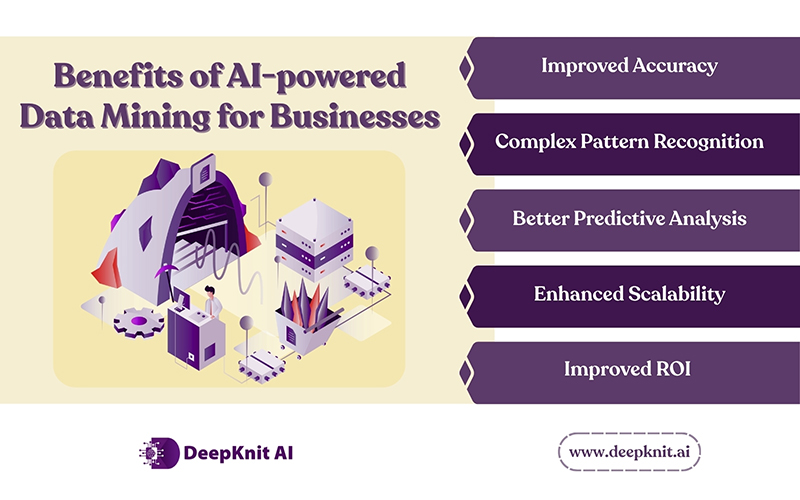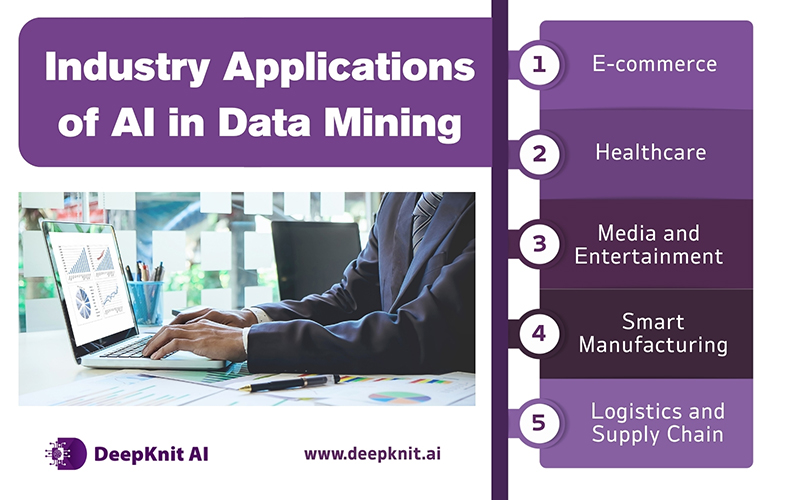Data has become the lifeblood that drives innovations, critical business decisions, and strategy formulation across industries. Businesses must learn to draw actionable insights from data but then comes the question of how to pick and choose from what is needed and what to ignore from such a big pool of data at their disposal. This is where data mining comes into play. Data mining is essentially the process of understanding data by means of cleansing it, identifying patterns and hidden values, creating models and testing them. With the advent of AI data mining tools emerged a new means of data mining automation that could perform these tasks within a fraction of the time traditionally utilized for data mining. These tools have managed to accomplish what was humanly impossible, i.e. dig out relevant information from bytes and bytes of data and that too in a much shorter span of time and with accuracy.
However, before exploring the topic of AI in data mining process, let’s take a look at the evolution of the process of data mining for a better understanding.
Data Mining through the Ages
Would it surprise you to know that the practice of data mining predates the advent of computers? Roughly around the early 1800s researchers used Bayer’s theorem and regression analysis to identify trends, patterns, and relationships in data. However, it was only after the discovery of Turing Universal Machine (1936) and neural networks (1943), that data mining started gathering interest and understanding in the modern sense.
The following is a quick timeline of the evolution of data mining:
- 1950s to 1960s: Data mining was popularized with the rise of computer science. This decade saw the introduction of foundational algorithms like genetic algorithms and decision trees, which laid the foundation of data mining services.
- 1960s to 1970s: This era saw the establishment of databases, which enabled a structured way of storing and organizing information. This structured and logical arrangement of data made the retrieval and analysis of data more convenient, which paved the way for sharper data mining techniques.
- 1980s to 1990s: This decade witnessed the coinage of the term ‘data mining’ and marked the beginning of the process of modern data mining as we know it, facilitated by the advancements in computing power.
- 1990s to 2000s: Data mining became mainstream during this period and saw a boom in its adoption across industries. It also witnessed the convergence of artificial intelligence (AI), machine learning (ML), and statistics to power highly sophisticated data mining algorithms.
- 2000s to the Present: The last two decades have witnessed a meteoric rise in computing resources and advancements. Data mining firms now leverage AI and ML to automate the end-to-end process, from collecting and preparing data to predicting outcomes.
Data mining companies will continue to thrive with the advancements in AI and ML, as processing data, extracting insights, and automating tasks become increasingly seamless, scalable, and flexible.
Top 5 Data Mining Techniques Employed Today
Data mining techniques are nothing but core strategies and machine learning algorithms that enable recognizing patterns, correlations and trends that are hidden or not so apparent in large datasets. The most effective data mining techniques for knowledge discovery being employed currently are as follows:
-
- Classification
Machine learning enables the effective performance of this technique that assigns items into predefined categories. Classification employs models like decision tree, random forest, and deep neural network, and is best suited for fraud detection, credit scoring and email filtering.
-
- Anomaly Detection
As the name itself suggests, this technique is useful in detecting any abnormalities or fraud detection and enhances network security. Its neural networks are made faster and better to effectively detect normal to subtle abnormalities in real time with the integration of AI.
-
- Regression Analysis
Regression analysis is a statistical technique most effective, and typically used for foreseeing numerical results like sales prospects, stock price changes and more. The enhanced versions of machine learning models, like gradient boosting and neural regression, have improved traditional linear regressions in accuracy. This technique is largely used in finance and healthcare industries.
-
- Clustering
Clustering is a technique based on machine learning and is used to group similar objects or data points into clusters, where objects within each cluster are more similar than the ones in the other. The data points do not have predefined labels enabling unsupervised learning. Advancements in AI have led to significant transformation in clustering methods with the introduction of evolving algorithms like DBSCAN and self-organizing maps. Clustering is used to discover hidden patterns and structures within data, and is used in various fields, such as customer segmentation, image analysis, fraud detection, and anomaly detection.
-
- Association Rule Learning (ARL)
A rule-based machine learning technique, association rule learning is used to discover interesting relationships or associations between variables in large datasets. ARL algorithms such as Apriori suggest that if item X is there, then there is a strong possibility of the presence of item Y as well. ARL is widely used for market-basket analysis, medical diagnosis, text mining, and recommendation systems.
Benefits of AI-powered Data Mining for Businesses
It must have become evident by now that though data mining is not something new, the advent of AI has taken it to newer and higher levels. Let’s see how AI has improved data mining:
-
- Improved Accuracy
AI and machine learning algorithms have the capability for continuous learning and improvement. This enables the data mining process to be less prone to errors, thereby improving efficiency and accuracy.
-
- Complex Pattern Recognition
AI is adept at recognizing patterns and correlations in complex datasets, both structured and unstructured. AI enables processing data in various forms like images, videos, IoT logs and even social media posts. This level of data analysis makes it possible to identify patterns and trends that might have otherwise stayed hidden.
-
- Better Predictive Analysis
By automating and speeding up data processing with minimal errors, and improved accuracy, AI significantly improves predictive analysis for better decision making. AI tools for predictive analytics and forecasting enables real-time estimations, proactive risk management, and personalized customer experiences.
-
- Enhanced Scalability
Unlike traditional data mining, AI-enabled data mining can be used to handle high volumes of data at scale, which significantly improves the speed and accuracy of the process to deliver rich insights in real time. This gives the edge to AI-enabled data mining services to be more responsive and resilient to changing market trends.
-
- Improved ROI
AI can seamlessly and effortlessly automate and streamline the entire data mining process, which means lesser dependency on limited resources like time and human labor. This can help you optimize your investments and thereby attract better returns.
Industry Applications of AI in Data Mining
AI data mining tools can be employed across industries to reap benefits at different levels. Let’s take a look at some of the common industrial applications of AI-powered data mining:
-
- E-commerce
Retailers or online sellers can easily leverage the AI capabilities of data mining to dig out relevant information from customers’ browsing data to create personalized recommendations within seconds. It helps in segmenting customers, dynamic pricing analysis, and market basket analysis.
-
- Healthcare
AI-powered data mining has many applications in the healthcare industry from real-time tracking of epidemics to personalized treatment recommendation for patients. The advanced AI algorithms can easily detect potential health complications in a patient, which helps doctors adopt preemptive treatment methods. It also finds use in many diagnostic and pharmacology procedures.
-
- Media and Entertainment
Media and entertainment channels use AI-driven models that help in real-time behavioral data mining, clustering, and collaborative filtering to analyze your browsing history to deliver tailor-made content that suits your taste and interest.
-
- Smart Manufacturing
AI-enabled IoT devices and sensors let manufacturers predict technical breakdown of their equipment. This lets them avoid costly downtimes.
-
- Logistics and Supply Chain
Logistics and supply-chain companies can leverage the advanced predictive capability of AI-powered data mining services to foresee stock shortage or overstocks. It helps in optimizing inventory, routes, and delivery times by analyzing real-time data insights.
Conclusion
AI in data mining has introduced predictive modeling that can smartly analyze future trends and prospects in real time and suggest anticipatory strategies. This approach to data mining has completely changed the way businesses operate. This great combination of machine learning algorithms, scalable tools, and real-time data insights enables a business to derive deeper, faster, and more accurate insights.
Whatever the type and size of your business is, leveraging the advanced capabilities of AI data mining tools can give you a competitive edge over your rivals. Partnering with AI experts like DeepKnit AI, is the first step to move forward.
Empower your business with AI-driven Data Mining.
Consult with DK AI’s experts.
Contact Us for a Demo



